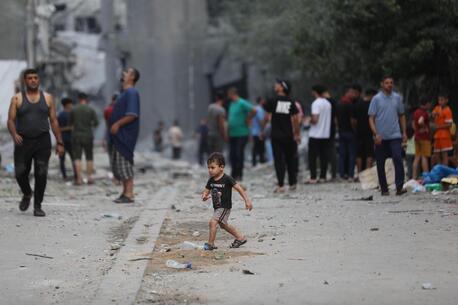
Gaza and Israel: The Cost of War Will Be Counted in Children’s Lives
Thousands of kids have reportedly died since this war began. Those who survive might be scarred forever.
The true cost of the violence in Gaza and Israel will be measured in children’s lives — those lost to the violence and those forever changed by it.
Less than three weeks on from the horrific attack inside Israel and the start of daily bombings of the Gaza Strip, the devastating tally in Israel and Gaza is quickly adding up. More than 2,700 Palestinian children have been killed and nearly 6,000 injured, according to Gaza's Ministry of Health, for a shocking average of over 480 child casualties per day.
More than 30 Israeli children have reportedly been killed, while at least 20 remain hostage in the Gaza Strip, their fates unknown.
Sadly, more suffering and death is on the horizon.
Gaza is one of the most densely populated places on Earth — home to more than 2 million people, nearly half of whom are children. More than 1 million people in the north have been warned to move south, ahead of what is expected to be a wide-scale military operation. But with near constant shelling, closed borders and little room for movement, there is nowhere truly safe to go.
Meanwhile, what clean water remains is quickly running out, leaving many Gazans with little choice but to rely on polluted wells. This dramatically increases the risk of waterborne disease outbreaks. Unless access to safe drinking water is restored, people will die from severe dehydration and illness, with children the most vulnerable.
An initial limited shipment of lifesaving humanitarian supplies has entered Gaza through the Rafah crossing from Egypt. But this is not enough to meet the region's skyrocketing needs, as supplies of food, water, medicine and fuel continue to dwindle.
UNICEF has pre-positioned additional emergency supplies for up to 250,000 people at the Rafah crossing that can be brought into Gaza in a matter of hours, with more en route. Our staff have also continued to respond to the crucial needs of children across the Gaza Strip.
But without an end to the violence and full humanitarian access, the cost in children’s lives could grow exponentially.
And even when the fighting stops, the cost to children and their communities will be borne for generations to come. War not only kills people; it kills possibility, slamming the door shut on what might have been. Children who lost their lives will not grow up to be the people their communities needed them to become.
Children who survive could see their lives irrevocably altered through repeated exposure to traumatic events. Violence and upheaval can induce toxic stress, which can interfere with physical and cognitive development and cause mental-health problems in both the short and long term. Even before this latest escalation, more than 816,000 children in Gaza — three-quarters of its entire child population — were identified as needing mental health and psychosocial support.
Today, a 15-year-old child in Palestine or Israel has already lived through six major rounds of conflict and countless other violent incidents. She may have lost loved ones or friends. She may have been physically injured herself. She may have tried to take shelter as rockets and bombs flew overhead. And she may have lived most of her young life in a near-constant state of stress and fear. Even if she came through it all without a scratch, she will never be a child again.
Not even the unborn can escape the trauma of war. A baby in the womb will experience the trauma of her mother, and studies show that this could affect her development when she comes into the world. In this way, the trauma reverberates for generations.
In this war, as in all wars, children’s lives and their futures are the true currency that must be used to count the cost – and the cost is always unacceptable. Every right of a child has been trampled upon.
I implore the adults who perpetrate violence to agree to a humanitarian ceasefire and to ensure immediate, unrestricted and sustained humanitarian access throughout Gaza to allow humanitarian actors to safely reach civilians in need, save lives and prevent further human suffering. And I reiterate UNICEF’s call for the immediate and safe release of any children being held hostage in Gaza so that they can be reunited with their families.
We are decades into this cycle of violence and reprisal, and the longer it continues, the more we lose — and children lose most of all.
Catherine Russell is the Executive Director of UNICEF. This opinion piece was first published by The Atlantic.
HOW TO HELP
There are many ways to make a difference
War, famine, poverty, natural disasters — threats to the world's children keep coming. But UNICEF won't stop working to keep children healthy and safe.
UNICEF works in over 190 countries and territories — more places than any other children's organization. UNICEF has the world's largest humanitarian warehouse and, when disaster strikes, can get supplies almost anywhere within 72 hours. Constantly innovating, always advocating for a better world for children, UNICEF works to ensure that every child can grow up healthy, educated, protected and respected.
Would you like to help give all children the opportunity to reach their full potential? There are many ways to get involved.





